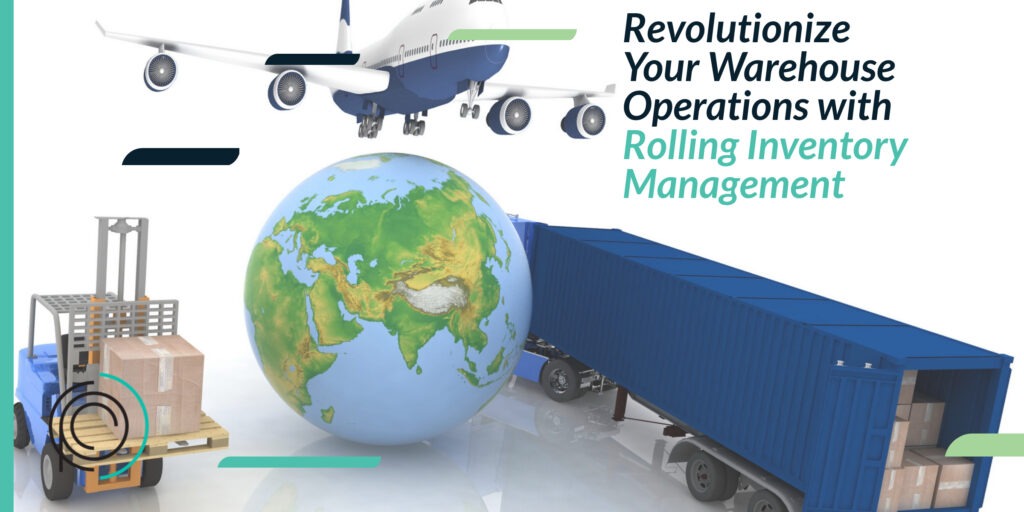Revolutionizing Logistics: How Rolling Inventory Management Transforms Warehousing into a Dynamic Distribution Hub
Imagine a warehouse that transcends the traditional role of simply storing inventory. Instead, envision it as a pivotal checkpoint in the distribution chain, crucial for efficiently delivering goods to customers. This is the core principle of rolling inventory management. Unlike the standard approach where warehouse workers unload goods from a delivery truck only to store them temporarily before eventually moving them to their final destinations, rolling inventory management revolutionizes this process. It treats the delivery truck as an integral part of the warehouse itself. Goods are managed in a way that they are continuously in motion, directly from the truck to their next point in the distribution chain without unnecessary delays or storage. This method not only streamlines the entire distribution process but also significantly reduces operational costs. By making the inventory management process more dynamic and fluid, companies can achieve faster delivery times, thereby enhancing customer satisfaction and competitive edge in the market. Through this innovative strategy, rolling inventory management aims to redefine traditional logistics, making it more agile and responsive to the fast-paced demands of today’s market.
In this comprehensive article, we’re going to delve into the intriguing concept of rolling inventory. We’ll break down how it operates in detail, explore the numerous benefits it offers to warehouse operations, and discuss why adopting this innovative inventory management strategy could be a game-changer for your warehouse’s efficiency and productivity. By understanding rolling inventory, you can optimize your stock levels, reduce overhead costs, and ultimately, enhance your business’s bottom line.
What is Rolling Inventory Management?
Rolling inventory management is a forward-thinking strategy designed to streamline the process of handling goods by eliminating the traditional steps of unloading and loading delivery trucks. In this innovative approach, inventory remains securely stored in the trailer, which is strategically parked in the warehouse yard until the time comes for its final delivery. This concept dramatically simplifies the logistics of moving goods.
The origins of rolling inventory management trace back to 2003 when it was first proposed by a team of insightful researchers at the University of Massachusetts in Amherst. They envisioned a method that could considerably reduce, if not completely eliminate, the expenses related to the labor-intensive tasks of unloading goods from a delivery truck and then reloading them for final distribution.
The primary goal of this strategy is to make the handling and distribution of goods more efficient and cost-effective. By maintaining trailers that are semi-full or fully loaded with inventory in the warehouse yard, businesses can significantly cut down on labor and handling costs. Furthermore, this method enhances operational efficiency by ensuring that products are always ready for dispatch, thereby speeding up the delivery process and improving service levels.
Rolling inventory management represents a shift towards more agile and responsive logistical operations. It aligns with the needs of modern businesses that require swift adaptation to market demands and customer expectations. By adopting this approach, companies can achieve a competitive edge, ensuring that they can deliver their products to the market faster and more efficiently than ever before.
The Advantages of Rolling Inventory Management
Rolling inventory management represents a groundbreaking approach that significantly impacts various aspects of warehouse operations. This innovative strategy offers a plethora of benefits, from substantial cost savings to enhanced delivery times, ultimately leading to heightened customer satisfaction.
One of the prominent advantages of adopting rolling inventory management is the notable improvement in space utilization within the warehouse environment. By strategically keeping inventory in trailers, companies can either completely eliminate or substantially reduce the necessity for additional space dedicated to storing products. This not only optimizes the use of available space but also contributes to a more organized and efficient warehouse layout.
Moreover, rolling inventory management significantly reduces labor and handling costs. Since it removes the need for products to be handled multiple times, this approach streamlines operations and cuts down on the labor required for managing inventory. This reduction in repetitive handling and movement of products not only lowers the risk of damage but also increases overall operational efficiency.
Another significant benefit of rolling inventory management is its positive impact on efficiency within warehouse operations. As the inventory is already loaded in the trailer upon its arrival at the warehouse, the cumbersome process of sorting and additional handling is completely bypassed. This not only accelerates the delivery process but also minimizes the potential for errors, ensuring that products reach their destinations more swiftly and accurately.
By implementing rolling inventory management, warehouses can achieve a marked improvement in customer satisfaction. This is primarily because products can be delivered more quickly and accurately, meeting or even exceeding customer expectations. Furthermore, the increased efficiency and cost-effectiveness of warehouse operations can also lead to competitive pricing, further enhancing customer satisfaction and loyalty.
Rolling inventory management is a transformative approach that offers numerous benefits for warehouse operations. From optimizing space utilization and reducing labor costs to improving operational efficiency and enhancing customer satisfaction, it presents a compelling strategy for companies looking to streamline their logistics and supply chain processes.
Implementing Rolling Inventory Management
Before diving into the implementation of rolling inventory management, it’s crucial for companies to thoroughly evaluate their specific business requirements to ensure that this strategy aligns well with their operational needs and objectives. This strategic approach necessitates a detailed analysis of several key factors. Companies should meticulously consider aspects such as space utilization within their premises, the handling costs that might be incurred, the estimated delivery times to maintain customer satisfaction, and the labor costs involved in moving and managing inventory.
Upon determining that rolling inventory management is the right fit, the next pivotal step is to develop a comprehensive plan tailored to the company’s unique needs. This plan must encompass detailed procedures for the efficient loading, unloading, and sorting of products. It should also include a well-thought-out strategy for product placement within the trailer to maximize space and accessibility, ensuring a smooth operation.
Moreover, for a successful transition to this new system, it’s imperative that companies invest in training programs for their employees. This training should cover all the new procedures and techniques involved in rolling inventory management, with a strong emphasis on safety and efficiency. Employees need to be well-versed in the operational changes to adapt quickly and maintain productivity.
Finally, once the implementation phase is underway, management plays a critical role in the continuous monitoring of performance against predefined benchmarks. This involves regularly assessing the effectiveness of the rolling inventory management system, identifying areas for improvement, and making necessary adjustments. Feedback from both employees and customers can provide valuable insights into how well the system is functioning and where it could be optimized.
Rolling inventory management presents a variety of advantages, such as optimized space utilization within warehouses and the potential for reduced handling costs, which can significantly affect overall operational efficiency. However, its successful implementation hinges on meticulous planning that accounts for the unique needs of the business, comprehensive training for employees to ensure they are fully adept at managing inventory this way, and persistent management oversight to address any issues promptly. Furthermore, it’s vital for companies to continuously monitor and adjust their inventory strategies in response to changing market demands or internal operational shifts. By dedicating the necessary resources and attention to these critical elements, companies can maximize the benefits of rolling inventory management, leading to improved product availability, reduced waste, and ultimately, higher customer satisfaction and profitability.
Rolling inventory management stands as a revolutionary strategy for warehouses aiming to elevate their efficiency, minimize handling expenses, and bolster customer satisfaction. This approach fundamentally transforms traditional warehouse operations by eliminating the time-consuming process of unloading and loading delivery trucks, thus significantly streamlining the delivery workflow and slashing operational costs. Instead of storing goods inside the warehouse, this method involves keeping the inventory within a trailer, which can be easily moved and accessed as needed. This not only optimizes the use of warehouse space but also opens up avenues for potential cost reductions in storage and maintenance. Furthermore, by adopting rolling inventory management, warehouse managers can achieve a more flexible and responsive logistics operation, capable of adapting to varying demand levels without the need for extensive reorganization within the warehouse. Implementing rolling inventory management is an innovative leap forward, offering numerous benefits, yet it demands meticulous planning and consideration. It requires a thorough assessment of the current logistical infrastructure, a clear understanding of the potential impacts on supply chain dynamics, and an investment in training for staff to adeptly manage the new system.
Companies should carefully assess their unique operational requirements and craft a detailed plan tailored to incorporating this strategy seamlessly. Rolling inventory management stands out as a promising solution, potentially leading to significant cost reductions, heightened operational efficiency, and the capability to provide customers with quick and precise deliveries. This approach not only streamlines warehouse operations but also aligns with modern demand-driven supply chain practices, ensuring that inventory levels are constantly adjusted based on real-time sales data. Wondering how to fine-tune your warehouse operations to fully leverage the advantages of rolling inventory? Don’t miss out on the opportunity to enhance your inventory management strategy. Book a no-obligation consultation with one of our expert consultants today and take the first step towards optimizing your warehouse operations for superior performance and customer satisfaction.







